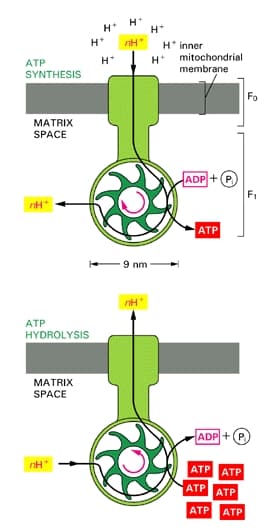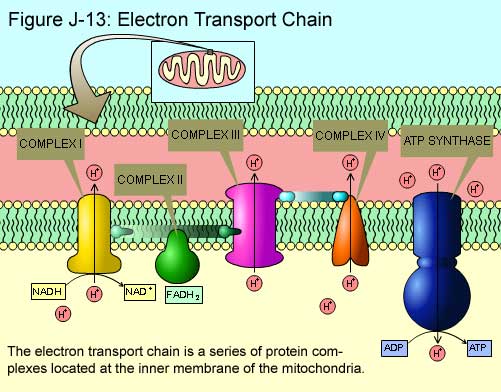- NADH and FADH2 carry electrons to the ETC
- Each become oxidized, losing two electrons to the ETC
The Electron Transport Chain (ETC) Structure
- Located within the inner mitochondrial membrane
- Composed of various protein structures arranged in order of increasing electronegativity
- Ex. weakest electron attractor (NADH dehydrogenase) is at the beginning of the chain and the strongest (cytochrome oxidase) at the end
How it Works:
- Electrons pass from one component protein in the chain to the next
- As they move from molecule to molecule they occupy ever more stable position relative to the nuclei of the atoms they associate with;
- Free energy released in the process is used to move protons [H+ ions] from the mitochondrial matrix to the intermembrane space
- Electrons reaching the end of the chain are in very stable positions and require the extremely electronegative oxygen to remove them from the ETC
IMPORTANT:
- NAD+ and FAD+ are in limited supply and must be oxidized by the ETC to reuse them
- Electrons must be removed from the ETC by oxygen to keep the ETC working
NADH:
- Drops electrons off at first complex; moves 3 H+ ions; produces 3 ATP
- GLYCOLYSIS: NADH cannot penetrate the mitochondrial inner membrane, however a membrane shuttle transfers electrons from the glycolysis NADH to FAD to produce FADH2

FADH2:
- Drops electrons off at cytochrome Q; moves 2 H+ ions; produces 2 ATP
Chemiosmosis and Oxidative ATP Synthesis
- The intermembrane space is impermeable to H+ ions
- Pumping H+ ions out of the matrix and into them intermembrane space creates an electrochemical gradient
- Electron free energy is transferred to potential energy in the electrochemical gradient
Electrochemical gradient:
- Higher positive charge [H+ ions] in the intermembrane space than in the matrix
- Higher concentration of H+ ions in the intermembrane space than in the matrix
Proton-Motive Force (PMF):
- Created by the H+ ions desire to move away from each other because they repel one another (like charges) and the want to diffuse into the matrix (low H+ conc.)
- Causes H+ ions to move around in the intermembrane space
ATP Generation:
- Unable to move through the inner membrane, H+ ions are forced to move through special protein channels called ATP synthase
- Free energy of the electrochemical gradient drives the synthesis of ATP from ADP and Pi in the matrix; chemiosmosis


Thank you very much
If you would like to use an image on this site, you may do so but please provide appropriate credit to this website. You MUST include either: A) a link back to the original article containing the image or B) a full MLA citation referring back to the original article containing the image.
To whom it may concern,
My name is Berenice Rivera Cruz and I am currently a doctoral student in the program of Nurse Anesthesia at Virginia Commonwealth University.
As part of my degree requirements I wrote an article in Mitochondrial Myopathies. I have been asked to submit it for publication in the American Association of Nurse Anesthetists Journal and wanted to obtain permission to include your Figure J-13:Electron Transport Chain in it with all due credit, of course.
Please let me know what you would require to grant me this authorization.
Have a wonderful Holiday Season!
Very truly yours,
Berenice Rivera Cruz